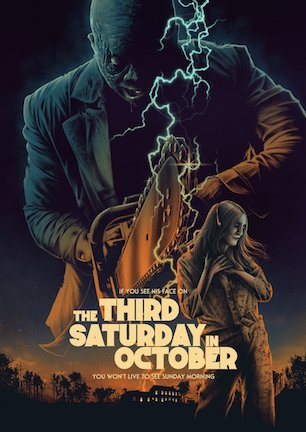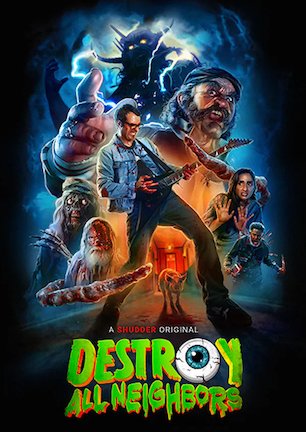Studio: Dark Sky Films
Director: Jay Burleson
Writer: Jay Burleson
Producer: Frank Crafts, Lauren Musgrove, Ian J. Cunningham, Jay Burleson
Stars: Darius Willis, K.J. Baker, Allison Shrum, Lew Temple, Casey Aud, Veanna Black, Kate Edmonds, Dre Bravo, Richard Garner, Libby Blake, Onur Tukel, Antonio Woodruff
Review Score:
Summary:
After inexplicably surviving his execution, an unstoppable serial killer embarks on a rampage on the day when a small town celebrates an annual college football tradition.
Review:
If you arrived at this review of “The Third Saturday in October” before watching or reading about “The Third Saturday in October Part V,” you’re technically going backwards, even though it shouldn’t seem that way. For the benefit of those who may have viewed the movies out of their intended order without realizing it, let me explain, or re-explain in the event you’re already aware of how these two retro horror/comedies are supposed to tie together.
The meta story surrounding “The Third Saturday in October” and “The Third Saturday in October Part V” is that they belong to a fictional slasher film franchise that enjoyed cult popularity during its heyday, but the series was eventually forgotten by everyone except its most ardent fans and essentially vanished. The first and fifth films have since been restored, and audiences can now finally relive these throwback thrillers that have rarely been seen outside of their respective release years of 1980 and 1994.
That’s the “in universe” idea behind the movies. In our world, writer/director Jay Burleson’s idea was to recreate a conundrum often confronted in video stores in the ‘80s and ‘90s. Namely, having rental options limited by whatever the store happened to have on hand. Maybe the shelves stocked four “Puppet Master” movies. Maybe they only had two. In any case, you were at someone else’s mercy, which made watching a series out of order or even completely skipping some sequels a common occurrence.
To imitate that sort of circumstance, the filmmakers want viewers to watch “The Third Saturday in October Part V” before watching “The Third Saturday in October” so they get a similar feeling of missing some background and having to play catch-up. As noted in my review of “Part V” though (review here), I don’t see how an average person is supposed to know this since it isn’t spelled out by the movies themselves, but by a press release they maybe never laid eyes on.
Then again, as also noted in that review, I don’t see much difference in the overall experience no matter which movie comes first. The two stories are completely separate, with the killer, town, and titular local holiday as the only things they share in common. And since parts two through four don’t actually exist, you’re going to get some kind of slightly jarring jump even if you do screen Part I prior to Part V.
I would still suggest watching Part V before Part I, mainly because the “sequel” is a notch above the “original” on just about every level where they can be compared, e.g. acting, plotting, execution, etc. After having a decent amount of fun with Part V, I was looking forward to how the first film would continue building on that foundation only to be underwhelmed by the duller direction it takes. It’s hard to say for certain since it didn’t happen that way, but I believe if I had watched the movies in numerical order, I wouldn’t have been as eager to check out Part V after seeing Part I first.
Part I’s setup is similar to Part V’s, and just as thin. In 1968, serial killer Jakkariah “Jack” Harding went on a murder spree in the small Alabama border town of Hackleburg before being captured. 11 years later, he’s set for electrocution. Somehow, Harding survives his execution, escapes, and heads back to Hackleburg in a stolen hearse on the third Saturday in October. That’s when residents traditionally party together during an annual college football rivalry, giving Harding a fresh crop of throats to slash while they unsuspectingly rah-rah around their TVs.
As with Part V, “The Third Saturday in October’s” period details are terrific, and the film recreates 1980 without swinging a sledgehammer in your face about it, like many retro efforts are prone to do. The diner decorated with wax-coated Coke cups and a lettered menu board looks great. Ditto the green-carpeted rumpus room with wood-paneled walls. Either the production team did an outstanding job with set dressing, or copious kudos should go to whoever found locations that look like immaculately preserved exhibits from a pop culture museum.
Burleson has an equally careful eye for his film’s horror references too. Many homages are obvious, but not insult-your-intelligence obvious, except for nods to names like Craven or Gunnar Hansen. Burleson understands his “Third Saturday in October” movies appeal chiefly to longtime horror hounds, so he doesn’t have to turn them into full-blown “Scary Movie” spoofs for viewers to recognize a character’s similarity to “Halloween’s” Nurse Chambers, a “Texas Chain Saw Massacre” hammer murder, or a makeup job that mirrors a distinct “Dawn of the Dead” zombie.
Keen attention doesn’t apply to all of the movie’s essential ingredients, however. A couple of issues from Part V carry over here, specifically the look of the killer, somehow made worse by not having his crude Halloween mask, making him even more lackluster as an anemic enemy with no distinguishing personality whatsoever.
Not only that, the story’s sequencing feels more unfocused than Part V’s comparatively tighter pacing. A number of bizarre bits are inexplicably inserted without any rational payoff. Some of these head-scratching scenes include an awkward encounter with a presumably racist gas station attendant, a truly annoying tic where characters suddenly meow at each other, and another weird sequence where Harding slashes a sleeping man’s arm for no discernible reason, then the man barely makes a quick mention of his mutilation when he wakes up. If I didn’t know better from Part V’s stronger structure, I’d have suspected “The Third Saturday in October” was making up stuff as it went along to stretch itself out to feature length.
It could simply be that the overarching gimmick is only good for 90 minutes of entertainment, not necessarily 180. Perhaps having watched Part V almost immediately prior might have made “The Third Saturday in October” more disappointingly tiresome than it would have been on its own. Even with different eras and tropes being lampooned, the similar gags get a little long in the tooth. Unless you were absolutely miserable, if you see one, you might as well see the other. Just be aware that you might have a different experience depending on which one you watch first, and it might not be the experience intended.
Review Score: 55







No matter what a viewer gets out of the movie, there’s an inescapable sense that its disparate parts are still missing key pieces.